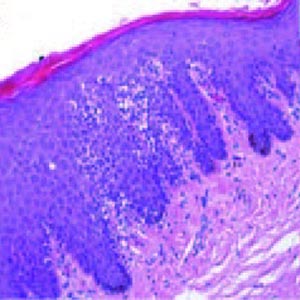Lichen sclerosus in pediatric age: A new disease or unknown pathology? Experience of single centre and state of art in literature

Submitted: 8 September 2021
Accepted: 27 January 2022
Published: 1 March 2022
Accepted: 27 January 2022
Abstract Views: 1951
PDF: 562
HTML: 25
HTML: 25
Publisher's note
All claims expressed in this article are solely those of the authors and do not necessarily represent those of their affiliated organizations, or those of the publisher, the editors and the reviewers. Any product that may be evaluated in this article or claim that may be made by its manufacturer is not guaranteed or endorsed by the publisher.
All claims expressed in this article are solely those of the authors and do not necessarily represent those of their affiliated organizations, or those of the publisher, the editors and the reviewers. Any product that may be evaluated in this article or claim that may be made by its manufacturer is not guaranteed or endorsed by the publisher.
Similar Articles
- Roberta Barachetti, Elisabetta Villa, Mario Barbarini, Weaning and complementary feeding in preterm infants: management, timing and health outcome , La Pediatria Medica e Chirurgica: Vol. 39 No. 4 (2017)
- Fabio Mosca, Maria Lorella Giannì, Human milk: composition and health benefits , La Pediatria Medica e Chirurgica: Vol. 39 No. 2 (2017)
- Salvatore Fabio Chiarenza, Cosimo Bleve, Ciro Esposito, Maria Escolino, Fabio Beretta, Maurizio Cheli, Vincenzo Di Benedetto, Maria Grazia Scuderi, Giovanni Casadio, Maurizio Marzaro, Leon Francesco Fascetti, Pietro Bagolan, Claudio Vella, Maria Luisa Conighi, Daniela Codric, Simona Nappo, Paolo Caione, Guidelines of the Italian Society of Videosurgery in Infancy for the minimally invasive treatment of pediatric nephrectomy and partial nephrectomy , La Pediatria Medica e Chirurgica: Vol. 39 No. 3 (2017)
- Leone Giordano, Salvatore Toma, Francesca Palonta, Roberto Teggi, Marco Zucconi, Stefania Di Candia, Mario Bussi, Obstructive sleep apnea in Prader-Willi syndrome: risks and advantages of adenotonsillectomy , La Pediatria Medica e Chirurgica: Vol. 37 No. 2 (2015)
- Chiara Costantini, Federica Fati, Elisa Pani, Fabio Beretta, Silvia Bisoffi, Giosuè Mazzero, Elisa Negri, Clara Revetria, Hamid R. Sadri, Enrico Ciardini, Two-balloon epistaxis catheter to ensure vaginal patency in a complex case of vaginoplasty for vaginal agenesis: a case report , La Pediatria Medica e Chirurgica: Vol. 45 No. 2 (2023)
- Agostino Berio, Attilia Piazzi, Carlo Enrico Traverso, Kearns-Sayre syndrome with facial and white matter extensive involvement: a (mitochondrial and nuclear gene related?) neurocristopathy? , La Pediatria Medica e Chirurgica: Vol. 39 No. 4 (2017)
- S. Caiulo, C. Gargasole, V. Gianfredi, V.A. Caiulo, Nephrogenic remnants: occasional ultrasound diagnosis and follow-up , La Pediatria Medica e Chirurgica: Vol. 36 No. 4 (2014)
- Alessandro Calisti, Diaaeldinn Yaseen Salman, Kibreab Belay, Andrea Mombo, Boniphace Tresphory, Giovanni Giuliani, Martina Sertori, Gian Battista Parigi, The hidden burden of Pediatric urology in Sub-Saharan Africa: an analysis of hospital admission data from three East African Health Centres , La Pediatria Medica e Chirurgica: Vol. 46 No. 1 (2024)
- Sara Ugolini, Lorenzo Tofani, Elisa Zolpi, Louise Montalva, Cosimo Lotti, Antonino Morabito, Fabio Chiarenza, Arnaud Bonnard, Morbidity related to major lung thoracoscopic resections in children , La Pediatria Medica e Chirurgica: Vol. 46 No. 2 (2024)
- Enrica Caponcelli, Milena Meroni, Giulia Brisighelli, Claudia Rendeli, Emanuele Ausili, Piergiorgio Gamba, Antonio Marte, Barbara Daniela Iacobelli, Laura Lombardi, Ernesto Leva, Paola Midrio, Transanal irrigation (TAI) in the paediatric population: Literature review and consensus of an Italian multicentre working group , La Pediatria Medica e Chirurgica: Vol. 43 No. 1 (2021)
You may also start an advanced similarity search for this article.

 https://doi.org/10.4081/pmc.2022.275
https://doi.org/10.4081/pmc.2022.275




